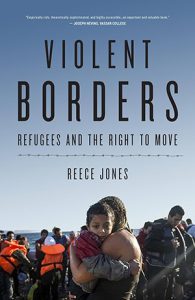Violent Borders: Refugees and the Right to Move

Author: Reece Jones
Publisher: Verso Books
Year of Publication: 2017
Print Length: 224 pages
Genre: Non-Fiction / Political Science
Topic: Asylum & Asylum Seekers, Refugees & Forced Migration, Asylum & Refugee System, Migrants, Foreign/Migrant Workers, Immigration Control, Migration, Borders, Movement of People and Ideas, Freedom to Move and to Stay, Fundamental Rights and Liberties, Legality & Illegality, Climate Change, Environmental Degradation, Ecology & Climate, Equality & Inequality, Poverty, Violence & Mass Violence, Security, Sovereignty, Globalization
A major new exploration of the refugee crisis, focusing on how borders are formed and policed
Forty thousand people died trying to cross international borders in the past decade, with the high-profile deaths along the shores of Europe only accounting for half of the grisly total.
Reece Jones argues that these deaths are not exceptional, but rather the result of state attempts to contain populations and control access to resources and opportunities. “We may live in an era of globalization,” he writes, “but much of the world is increasingly focused on limiting the free movement of people.”
In Violent Borders, Jones crosses the migrant trails of the world, documenting the billions of dollars spent on border security projects and their dire consequences for countless millions. While the poor are restricted by the lottery of birth to slum dwellings in the aftershocks of decolonization, the wealthy travel without constraint, exploiting pools of cheap labor and lax environmental regulations. With the growth of borders and resource enclosures, the deaths of migrants in search of a better life are intimately connected to climate change, environmental degradation, and the growth of global wealth inequality.
Table of Contents
Preface to the Paperback Edition
Acknowledgments
Introduction
1. The European Union: The World’s Deadliest Border
2. The US-Mexico Border: Rise of a Militarized Zone
3. The Global Border Regime
4. The Global Poor
5. Maps, Hedges, and Fences: Enclosing the Commons and Bounding the Seas
6. Bounding Wages, Goods, and Workers
7. Borders, Climate Change, and the Environment
Conclusion: Movement as a Political Act
Notes
Index

Reece Jones is Guggenheim Fellow and a Fellow of the American Association of Geographers. He is political geographer who studies the relationship between states, borders, and people on the move: “Why do we have borders? What impact do borders and the state system have on global inequality? What would a world without movement restrictions at borders look like?”. the author of four books, Nobody is Protected: How the Border Patrol Became the Most Dangerous Police Force in the United States (2022, Counterpoint), White Borders: The History of Race and Immigration in the United States from Chinese Exclusion to the Border Wall (2021, Beacon), Violent Borders: Refugees and the Right to Move (2016, Verso) and Border Walls: Security and the War on Terror in the United States, India and Israel (2012, Zed) and four edited books: Open Borders (2019), the Handbook on Critical Geographies of Migration (2019), Borders and Mobility in South Asia and Beyond (2018), and Placing the Border in Everyday Life (2014).
Source: https://www2.hawaii.edu/~reecej/ & https://geography.manoa.hawaii.edu/reece-jones/
More from Reece Jones in this library, click here.
